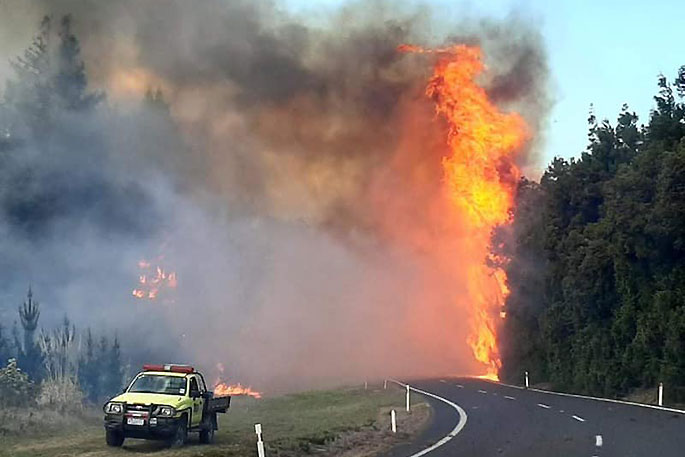Last summer seemed to be dominated by flooding but this year, fires are making headlines.
A state of local emergency was declared for Christchurch City, including Banks Peninsula and Selwyn District, on Wednesday evening after a fire broke out in the Port Hills.
By Thursday morning the fire had covered more than 600 hectares and more than 23 fire trucks were at the scene.
It's one of nearly 2700 wildfires that have occurred since the season started, in October.
There have been vegetation fires up and down the country. As well as fatal house fires, a large blaze at a waste facility, at a power transformer, smaller fires at shops and schools, and the list goes on.
Just hours earlier on Wednesday, a restricted fire season was put in place for Auckland and Northland, meaning it is an offence to light an open-air fire without a permit.
Expected dry weather in Auckland and high winds in Northland are driving fire danger to extreme levels, says Fire and Emergency regional manager Ron Delvin.
The Bay of Plenty is also in a restricted fire season. Read more here.
Fire and Emergency New Zealand national wildfire manager Tim Mitchell told RNZ the season so far, with extremes of wet and dry conditions, has been a "roller-coaster".
Meanwhile, across the ditch, firefighters are battling to protect communities in Victoria's west from bushfires.
Increasing risk
Scion, a Crown research institute, has produced research on how climate change is affecting wildfire risk and recommendations for mitigating it.
"As wildfire researchers, we know that fire conditions are worsening and there are more and more extreme fire days each year," Scion's Shana Gross told RNZ.
Climate change predominantly increases the risk by increasing temperatures and reducing moisture. The hotter and drier conditions increase both the frequency and severity of wildfire events.
More homes were destroyed during New Zealand's 2016-2017 fire season than have been in any of the previous 100 years (since the 1918 Raetihi Fire), according to Scion. And this was well surpassed in 2020-2021.
The areas of greatest risk are the seasonally drought-prone and arid locations.
The Mackenzie Country, Central Otago, and Marlborough are likely to experience conditions similar to those that led to the devastating fires in Australia in 2019-2020, for example.
But there is increasing risk to urban areas, too. Gross referenced fires this week that burnt more than 15,000 homes in the cities of Valparaiso and Vina Del Mar in Chile.
The season so far
New Zealand is feeling El Niño's influence this summer, with more intense winds leading to an elevated risk of drier-than-normal conditions in some areas and more rain in others.
Mitchell says the last two seasons were comparatively wet.
"Our concern was that the public wouldn't be prepared to return to a higher level of risk."
Quoting figures from 13 February, he says: "We've had 2698 wildfires impacting 4120ha so far this season."
Meaning the country is on track for an average season of 4500 wildfires affecting 7300-odd hectares, he adds.
"We're getting into the dryer part of the season now, which usually extends through March."
On February 14, the country's Te Hiku region (including Auckland and Northland) moved to a restricted fire season until further notice.
In a statement, Delvin says the high westerly winds are already causing "spike days" to occur in Northland where the fire danger is hitting the highest level of "extreme". There is a major risk of a fire occurring that will be "very difficult to control".
He emphasises the labour required to contain and control wildfires. A large wildfire in Northland near Cape Reinga in March, 2023, took eight days to extinguish at a cost of more than $1.5 million. A fire near Waiharahara in the summer of 2021-2022 burnt for 50 days at a cost of more than $10m.
Mitchell encourages anyone considering lighting a fire to check the current fire season status online. And not just before lighting a bonfire, he sys. Portable gas cookers and even lawn mowers can spark a blaze in the right conditions.
He describes several fires so far this season caused by outdoor smokers, while people were fishing nearby.
"If it involves the lighting of something, there's a fire."
Preventing fires
About 98 per cent of New Zealand's fires are caused by humans or human-related activity, Mitchell says. Meaning there is a lot we can do to prevent fires.
Even if the FENZ site says it is safe to light a fire, do not leave it burning unattended, Mitchell says. Afterwards, make sure it is thoroughly put out.
"We've seen hot embers from a main fire ignite another home up to three kilometres away," he says.
Shelterbelts - lines of vegetation planted to provide shelter from the wind - are a big issue now, he says. Often comprised of pines or other fast-growing trees, they drop a lot of debris which is prone to drying out and then igniting.
"A fire can build intensity, quicky. It climbs up the canopy and off it goes."
When planted along a driveway, an alight shelterbelt can prevent a fire truck from accessing a property.
"The radiant heat is too much."
FENZ in a document on the flammability of plant species advises the replacement of high flammability species with lower flammability ones can reduce fire hazard. Low flammability species can also be positioned to break up flammable landscapes.
Manuka and kanuka trees burn very easily, for example, while lancewood and five finger trees are listed as "low flammability".
"The best way to protect your house is to reduce the intensity of the fire as it approaches; this can be achieved by creating an area around your house where all flammable material such as scrub vegetation, long, rank grass, leaves and twigs has been removed."
Mitchell says while lavendar looks pretty against the house, "it burns very, very hot".



0 comments
Leave a Comment
You must be logged in to make a comment.